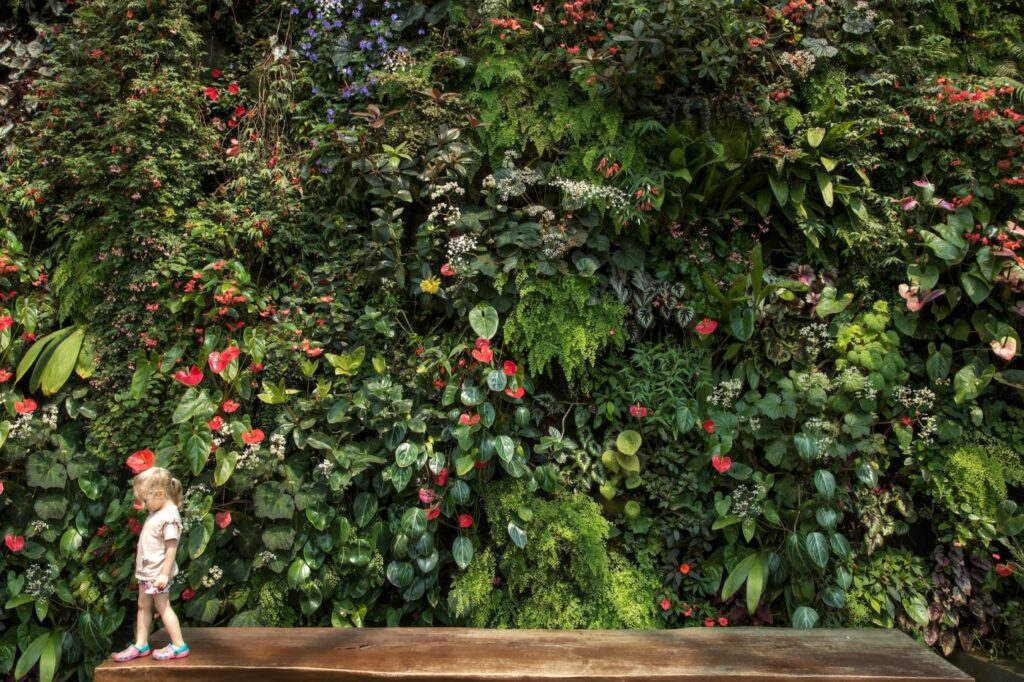
Walls with plants growing on them are turning up everywhere. And I am not just talking about vines that cling such as Boston ivy and creeping fig. It is now possible to cover any wall, exterior or interior, with vegetation in a variety of colors, textures, and forms. Such living walls are becoming an increasingly familiar sight at airports, commercial buildings and private residences as well, where both exterior and interior walls are candidates for vertical gardens.
David Brenner is the founder of Habitat Horticulture, a company that designs, installs, and maintains what he refers to as living walls. Brenner has installed more than 30 living walls in the Los Angeles area – at the Westfield Century City Mall, Del Amo Fashion Center, and Century Plaza Hotel among many others.
Exterior and interior walls of several Los Angeles homes have also served as canvases for Brenner’s horticultural works of art. There is nothing predictable about Brenner’s plant selections, which depend upon the whims of the client. These melanges of botanical species include ferns, geraniums, heucheras, coleus, orchids, parlor palms, bromeliads, and succulents, although this last category, Brenner confided, tend to become leggy when grown on walls.
It is now possible to procure a self-contained “mini living wall system” for your home or office. The unit – which goes by the name of Gromeo – arrives complete with plants and ready for hanging. The six-sided vertical planters, framed in birch wood, come in two sizes: approximately two feet by two feet and 18 inches by 18 inches.
Assorted plant combinations, depending on the amount of your available light, are available, but no electrical or plumbing work is needed to set up your unit. You simply fill the one-gallon reservoir at the base of the unit every two to three weeks. The plants are embedded in Growtex fabric – made from recycled plastic bottles – that wicks up the water in the reservoir below through capillary action. You can also order the wall system without plants and insert your own selections in the pockets provided.
To learn more about Gromeo, visit habitathorticulture.com. When you get there, click “shop” in the upper right-hand corner of the home page to access Gromeo wall planters.
Anyone with a wall planting experience is invited to send their story to me at the email address given below.
I asked readers to send me their orchid experiences. One of the responses included a photo of a brilliant, cherry red clutch of flowers from an Epidendrum orchid courtesy of Dee van Dam, who writes about it as follows: “I am not a fan of the foliage, but this plant redeems itself by blooming year around. I am in Ontario and my plant gets morning sun and afternoon shade.”
Jerry Kaufman, who gardens in Westminster, sent an impressive photo of a three-foot-long cymbidium orchid flower spike, festooned its entire length with perfect yellow blooms.
Kathleen Byrnes, who gardens in Pasadena, is seeking suitable perennials that “tolerate the blistering overhead sun of summer and continuous shade of winter” when planted along the north-facing wall of a garage or other building.
The first plant that comes to mind for the exposure you describe is star jasmine (Trachelospermum jasminoides), which could be trained into a hedge or secured to a trellis if you want it to reach the height of the wall. Japanese privet (Ligustrum japonicum) or glossy leaf privet (Ligustrum lucidum) would also be suitable for growing as a hedge in the location you described. They could be kept trimmed to any height you wish, from three feet to eight feet or more.
Related Articles
What to do when something weird is growing on tree bark
How to think like an interior designer when you redecorate your home
The hazards of falling trees after heavy rains: What to know
Learning lessons about dry climate gardening (even with the recent rain)
Gardeners, you can plant just about anything right now
Oakleaf hydrangea (Hydrangea quercifolia) could also work for you. It is tougher than the conventional hydrangea and can take more sun. Natal plum (Carissa grandiflora) has cultivars in various sizes and does well in both sun and shade. Finally, heavenly bamboo (Nandina domestica), an evergreen, is also blessed with many cultivars of various sizes, all of them bearing foliage that changes color with the seasons and suitable for a bright northern exposure.
I still prefer the old standby Nandina domestica that grows to a height of six feet and, due to its rhizomes, is virtually indestructible. It also makes an excellent container plant should you wish to make a row of containers in the area you mention.
California native of the week: The shrubby monkeyflower (Mimulus aurantiacus) may be the most endearing California native. Some say there is no rhyme or reason to their common name although others see a monkey’s face upon close inspection of a flower. They are evergreen or briefly deciduous woody plants of low stature, reaching three feet tall and four feet wide. Flowers are generally orange or apricot in color, but hybrids may bloom in red, pink, purple, or white. The plants are sometimes called sticky monkeyflowers as their leaves and flowers have a glutinous texture. They should be blooming now and, if you cut them back once flowering subsides, they may flower again in mid-summer. Due to our heavy rains this winter, however, they may flower continuously and heavily until August. Monkeyflowers can grow in either sun or partial shade.
Please send questions, comments, and photos to joshua@perfectplants.com.
